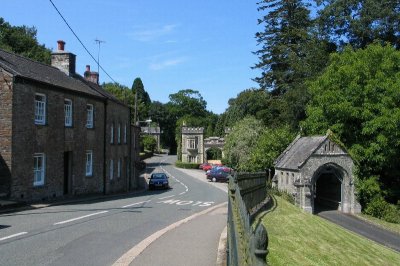


Quiet little village which once had a cathedral
Once a fishing village on the River Tiddy, built on high land at the confluence of the River Tamar and the River Lynher in the south eastern corner of Cornwall. It is accessed from the B3249 which crosses from the A38 to the A374. The population of the village was 2,460 at the 2011 census.
The parish church of St. Germans is dedicated to Saint Germanus and has an important history having been used as the cathedral of Cornwall from AD 931 in Saxon times, when King Athelstan established it, until Truro Cathedral was built in the 19th century.
At the time of the Domesday Book of 1086, the Manor of St. Germans Church fell within the Hundred of Rillaton and was owned by the Bishop of Exeter and the Canons. It was already important enough to be able to hold markets and fairs.
A Priory of Augustinian canons was established here in the late 12th century and much of this building, consecrated in 1261, still remains as a wonderful testament to the Norman architecture of the period. The west doorway is the finest example of Norman architecture in Cornwall and one of the finest in the U.K. The massive church has two towers dating from the 13th and 15th centuries. It was much dismantled by Henry VIII in 1539. Inside is a memorial to the Eliot family, whose home Port Eliot is beside the church.
Port Eliot is now owned by the present Earl (In 1815 John Eliot was created Earl of St. Germans). Car rallies, festivals such as the Port Eliot Lit Fest are sometimes held in the park and the house and its grounds are open to the public during the summer. The house contains an collection of paintings, including several works by Joshua Reynolds. It has a remarkable Tudor gateway. In the 16th century John Eliot bought the priory and it became part of the Port Eliot estate.
St. Germans village contains six picturesque 16th century Almshouses. Sir William Moyle's Almshouses, also known as the Galleries, date from 1583. They are unusual in that they consisted of six one-room apartments on the ground floor and a further six on the first floor.
The old Rotten Borough of St. Germans used to send two members to the House of Parliament until the Reform Bill of 1832.
St. Germans Quay was busy in the last century with cargoes of minerals, coal, timber and limestone, and a vigorous trade in road-stone continued until the last war.
St. Germans still has a railway station on the main line through Cornwall. St. Germans railway station was opened on 4th May 1859 at the west end of St. Germans viaduct, 106 feet above the quay.
Robert Scawen (1602–1670), English politician who sat in the House of Commons at various times between 1640 and 1670. He supported the Parliamentary cause in the English Civil War.
William Scawen (1600–1689), politician and key figure in Cornish language preservation.
Sir John Eliot (1592–1632), key Parliamentarian figure in the build-up to the Personal Rule of Charles I. Died in the Tower of London. Of the local Eliot family.
Henry Furneaux (1829–1900), British classical scholar.
Port Eliot Festival - End of July.
Catchfrench Manor Gardens Cornish Celtic Way Menheniot Port Eliot House Saltash